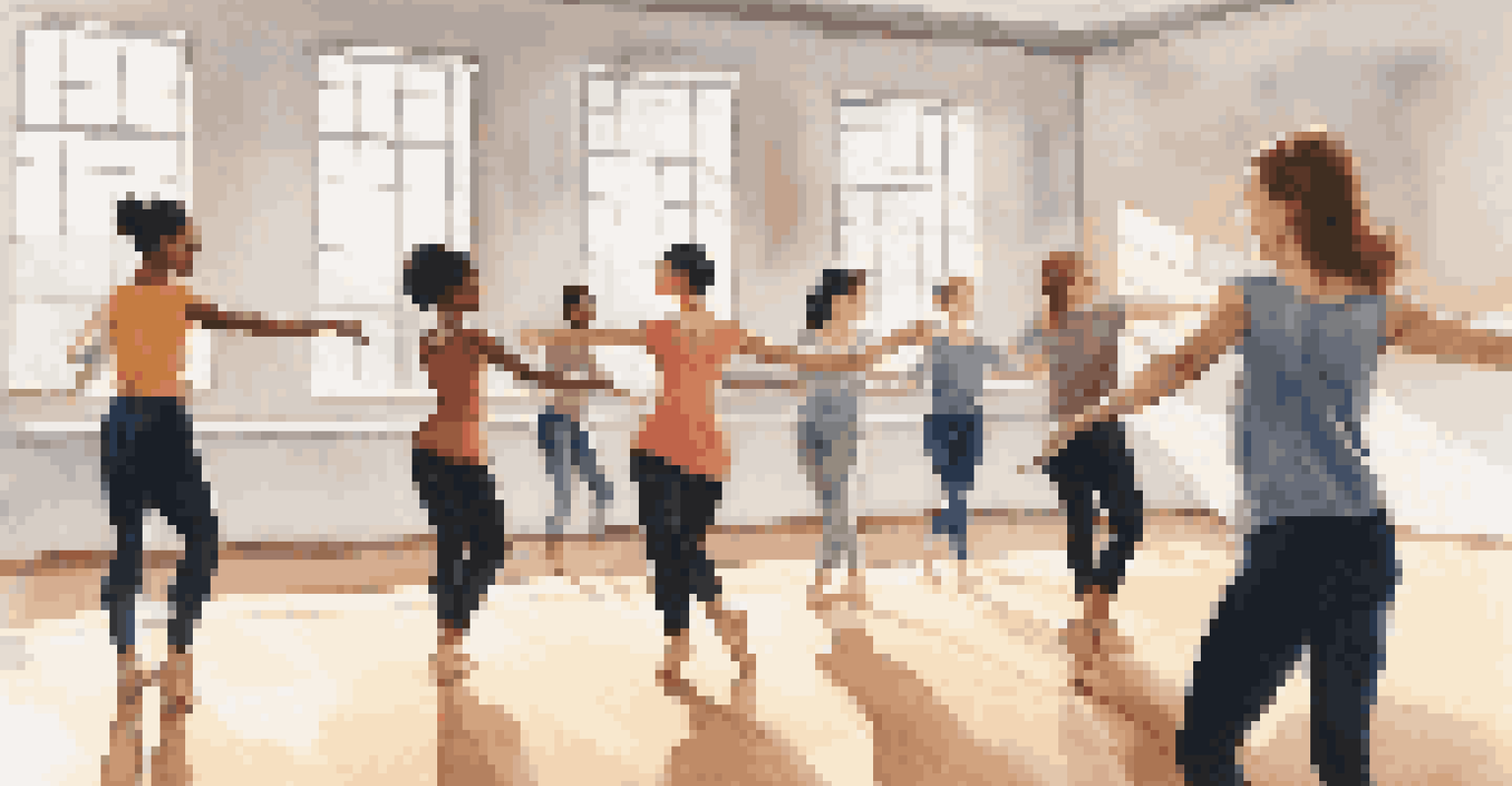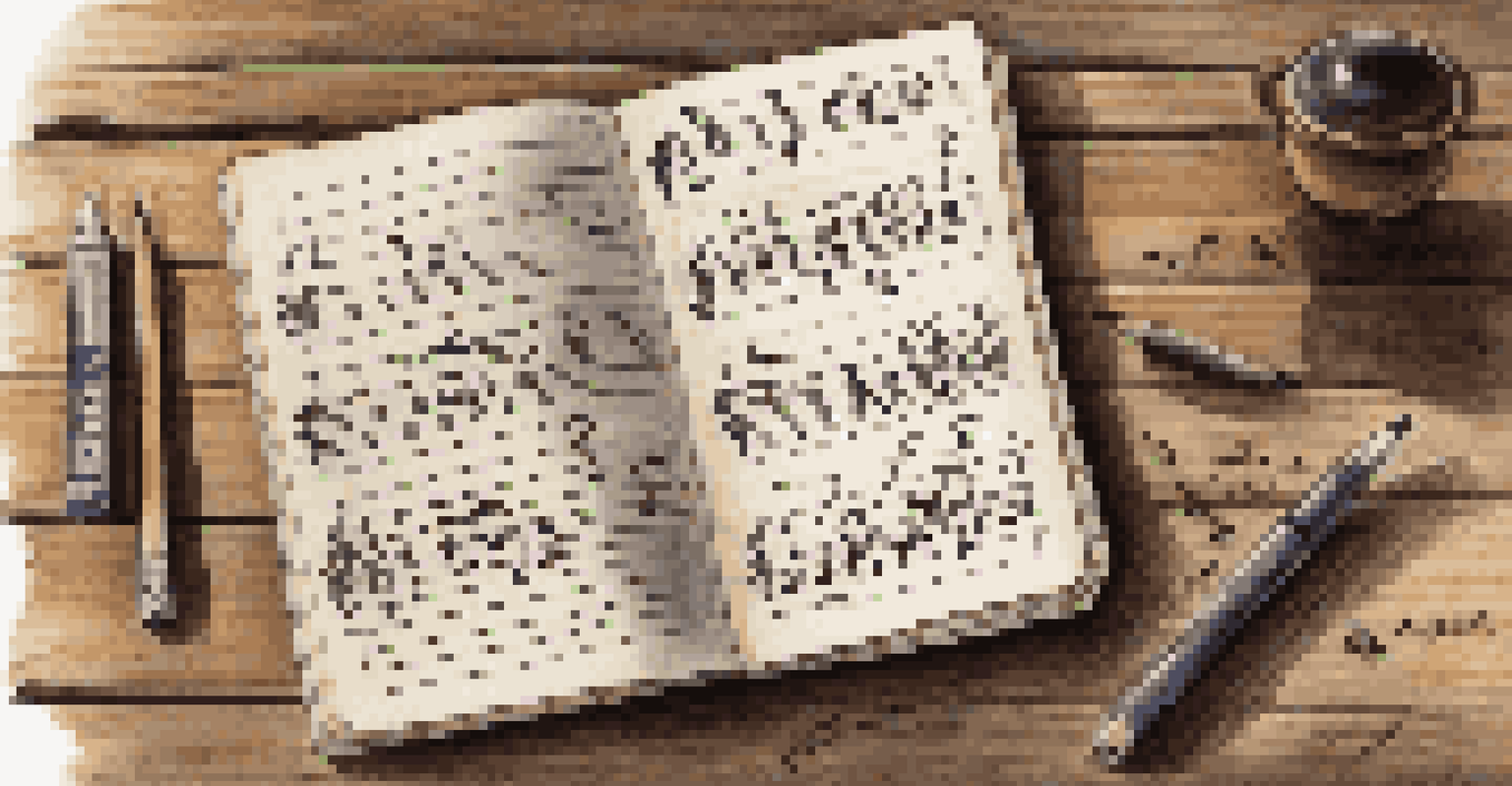Interpreting Dance Notation: Skills for Dancers and Teachers

Understanding Dance Notation: A Foundation for Movement
Dance notation is a system that visually represents movement, much like sheet music does for musicians. It provides dancers and teachers with a way to record choreography, ensuring that the essence of a dance is preserved over time. This system can appear complex at first, but at its core, it is a tool for communication and collaboration.
Dance is the hidden language of the soul.
By learning to read and write dance notation, dancers can gain insights into the structure and dynamics of a performance. It helps them understand not just the steps, but also the intent behind movements, which can enhance their interpretative skills. For teachers, it becomes an invaluable resource for instructing students and developing choreography.
Ultimately, understanding dance notation opens up new avenues for creativity and expression. It allows dancers to revisit and refine their movements, while enabling teachers to convey their vision more clearly. This foundational skill empowers both dancers and educators to connect deeply with the art of dance.
The Benefits of Dance Notation for Dancers
For dancers, mastering notation can be a game-changer. It provides a way to document personal choreography and ensure that it can be recreated accurately later. This skill not only boosts confidence but also encourages a deeper connection to the dance material, as they learn to interpret and internalize movements on a new level.

Moreover, being proficient in dance notation enhances a dancer's versatility. They can engage with a wider range of styles and techniques, as many forms of dance have their own notation systems. This adaptability not only makes them more marketable but also enriches their overall dance experience.
Dance Notation Enhances Learning
Understanding dance notation improves dancers' interpretative skills and facilitates clearer communication in choreography.
Additionally, understanding notation fosters collaboration among dancers. When working in groups or with choreographers, the ability to read notation allows for smoother communication and a shared understanding of the artistic vision. This collaborative spirit is essential in the dance world, where teamwork often leads to the most innovative performances.
How Dance Teachers Can Leverage Notation
Dance teachers can significantly enhance their teaching methods by integrating notation into their classes. It serves as a teaching aid that helps clarify complex sequences and can be used to create lesson plans that cater to various learning styles. For instance, visual learners may benefit from seeing movements written down, which complements the kinesthetic approach of learning through doing.
The body says what words cannot.
Moreover, notation allows teachers to document progress and tailor instruction to individual students’ needs. By assessing a dancer's ability to interpret and execute notated movements, educators can provide targeted feedback that accelerates growth. This personalized approach not only builds trust but also fosters a positive learning environment.
Incorporating notation into the curriculum prepares students for future opportunities in dance. Whether they aspire to perform professionally or pursue careers in choreography, having a strong grasp of notation will give them an edge. Teaching notation empowers the next generation of dancers to fully understand and appreciate the depth of their art.
Key Notation Systems Every Dancer Should Know
There are several notation systems used in the dance world, each with its unique features. One of the most popular is Labanotation, which uses symbols to represent movement qualities such as direction, duration, and effort. Understanding this system can help dancers articulate their movements with precision and clarity.
Another notable system is Benesh Movement Notation, which employs a staff-like structure to convey dance movements. It's particularly useful for ballet, as it captures the nuances of classical technique. Familiarity with these systems not only enhances a dancer’s skill set but also opens doors to various dance forms.
Teachers Benefit from Notation
Incorporating dance notation into teaching allows educators to tailor instruction and document student progress effectively.
Additionally, some contemporary choreographers may develop their own notation methods. Being adaptable and open to learning different systems can make dancers more versatile and better collaborators. Ultimately, the more notation systems a dancer is familiar with, the more equipped they will be to tackle diverse choreography.
Challenges in Learning Dance Notation
While learning dance notation can be incredibly beneficial, it does come with its challenges. Many dancers may initially find the symbols and terminologies overwhelming, leading to frustration. However, with patience and consistent practice, these hurdles can be overcome, just as with any new skill.
One common struggle is associating the written symbols with physical movements. Dancers may need to practice translating notation into action repeatedly to build fluency. This process can feel tedious at times, but it is essential for mastering the art of notation.
Additionally, not all dance styles have widely accepted notation systems, which can create confusion. Dancers and teachers may need to develop their personal shorthand or adapt existing systems to fit their needs. Embracing this creativity can be part of the learning journey, making the process even more rewarding.
Incorporating Notation into Dance Practice
To effectively incorporate notation into dance practice, start small. Dancers can begin by notating simple sequences or their favorite choreography. This practice not only reinforces memory but also builds confidence in using notation as a tool for learning and creativity.
Teachers can encourage students to engage with notation by assigning exercises that involve writing down movements. This could be as straightforward as documenting a class sequence or as complex as creating original choreography in notation form. This hands-on approach fosters a deeper understanding of movement and its structure.
Notation Systems Expand Versatility
Familiarity with various dance notation systems enhances dancers' adaptability and collaboration across different styles.
Creating a supportive environment where students feel comfortable experimenting with notation is crucial. Celebrating their successes and encouraging them to share their notated dances with peers can promote a sense of community and collaboration. This shared journey makes the learning process enjoyable and enriching for everyone involved.
The Future of Dance Notation in Education
As dance education evolves, the role of notation is becoming increasingly important. With the rise of technology, digital tools are emerging that make learning and applying dance notation more accessible. Applications and software designed specifically for dance can help both students and teachers engage with notation in innovative ways.
Furthermore, the integration of notation into dance programs is likely to expand. Educators are recognizing its value not only for preserving choreography but also for enhancing creativity and communication. As more institutions adopt these practices, the skills associated with dance notation will become essential for any aspiring dancer or choreographer.

Ultimately, the future of dance notation looks promising. By embracing this art form, dancers and teachers alike can cultivate a richer educational experience. As they continue to explore and innovate, the world of dance notation will evolve, fostering a deeper appreciation for the artistry of movement.